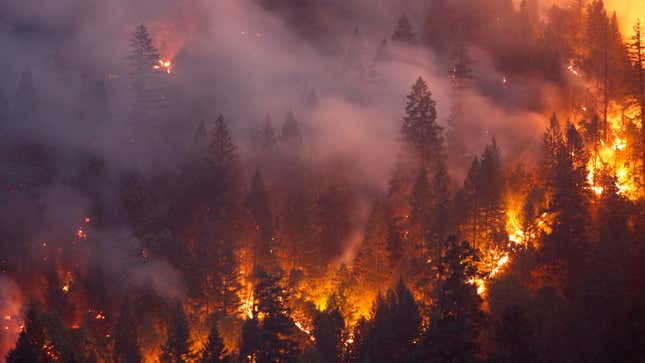
The climate crisis is bringing hellish conditions to the U.S. Drought? Yup. Heat waves? Big time. And when those two forms of extreme weather transpiring at the same time, the combination is devastating. Just look at what we’re seeing with the record-breaking wildfires out West.
New research shows that the U.S. is seeing a lot more instances of combined heat wave and drought events. And without drastic climate action, those disasters will happen more often—and get worse.
For the new study, published in Science Advances on Wednesday, researchers analyzed instances of extremely hot and dry weather over the past 122 years. To do so, they looked at precipitation and temperature data from 1896 through 2017 from the National Oceanic and Atmospheric Administration, and used several statistical and geospatial techniques to tease out patterns in the frequency, intensity, and locations of these climate catastrophes.
The authors found that in the last half century, the frequency of these spells of dryness and heat substantially increased across the West, as well as in parts of the Northeast and Southeast.
Using a form of analysis called joint probability distributions of climate observations, the authors determined what events qualified as 25-year, 50-year, and 75-year events (as in, events that should occur just once in every 25, 50, and 75 years). They found that these conditions transpire far more frequently than they used to. Progress—but the bad kind.

The study also found the areas that experience these compound events are becoming more clustered: Rather than a smattering of scattered regions seeing dry heat waves, the impacted areas are now larger and closer together, which can put a huge strain on regional and national relief efforts. To make matters worse, these climate emergencies are happening in more places. The authors observed that areas up north which were previously too wet and cold to see these combined events are now experiencing them.
The findings suggest that there’s been a shift in what causes these hot and dry events to happen. While the devastating heat and drought of the 1930s Dust Bowl was primarily triggered by a lack of rain, these days, extreme heat—which can cause moisture to evaporate—is the big driver.
“This is important because even in a slightly below normal precipitation year, we might observe moderate to severe drought,” Mojtaba Sadegh, an assistant civil engineering professor at Boise State University who co-authored the study, wrote in an email.
We’re already seeing how awful these climate emergencies can be. Dry heat is the perfect condition for wildfires to spark, especially when you throw some strong winds into the mix (again, see: this year’s fires out West).
And even without fires, hot, dry weather poses giant challenges for agriculture.
“If it is hot, you need more water for irrigation, and if there is drought, there is no water for that purpose,” Sadegh said.
This is all evidence that we need urgent action to curb the climate crisis, or we’ll risk more deadly fires and major damage to our food supply. But if you’re not convinced by, uh, the need to preserve conditions that can support human life, maybe the price tags will convince you. The authors note that in the U.S., three drought and heatwave events between 2011 and 2013 caused damages equaling roughly $60 billion.
Even if emissions drop to zero tomorrow, we’ll still need to adapt to this new hot and dry world, a point Sadegh stressed. We need to stop building new developments in fire-prone areas, improve our water irrigation systems, and make our agriculture systems more resilient. We also need to rebuild our ecosystems so they can withstand increasingly extreme stress.
“Reintroducing beavers to North American river valleys, for example, can be one approach to increasing water holding capacity of watersheds and enhancing resilience to climatic extremes,” Sadegh said.
Of course, we also need urgent action to draw down greenhouse gas emissions globally. Otherwise, we’ll just keep making America hotter and more dry at a rate we might not be able to adapt to.
“We need to act NOW! Aggressive emission cuts are needed today,” he said.